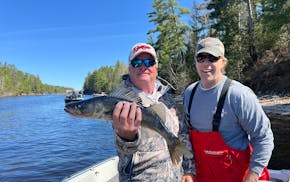People are fascinated by big fish, and the Department of Natural Resources, like other conservation agencies nationwide, keeps a list of "record'' fish caught in Minnesota — a program that requires anglers to tell the truth about the weight and/or length of their catches, a whopper of an expectation.
Now the DNR wants to clean up its nearly century-old big-fish record-keeping system and proposes to recalibrate the way it honors Minnesota's potential wall hangers.
"Are we required to have a record-fish program?'' said Shannon Fisher, DNR fisheries populations monitoring and regulations manager. "No, we are not. We do it because it's a fun thing, and it might get some people excited about fishing who otherwise wouldn't be.''
In a draft proposal released this week, the DNR acknowledges that the dozen Minnesota fish records established before 1980 might or might not be legitimate. Before that date the DNR didn't require record-fish submissions to be weighed on certified scales.
In fact, until 1950, the agency didn't keep formal records of big fish caught in Minnesota. It instead largely accepted as fact anglers' monster-fish claims — though at times their only validation was by Field & Stream magazine or other publications that took on faith anglers' tall tales.
With some anglers, the faith was misplaced.
In 1976, for example, the state's "record'' muskie was decertified after it was determined the fish was caught on the Ontario side of Lake of the Woods, not the Minnesota side. The state's largemouth bass record also has been the subject of various fantasy entries over the years.
Also suspect is the Minnesota smallmouth bass record, at 8 pounds and recorded as caught in West Battle Lake in 1948, as is the 5-pound black crappie record, supposedly caught in the Vermilion River in 1940. So, too, the 45-pound 12-ounce northern pike mark allegedly caught in Basswood Lake in 1929.
There's no proof these or the other pre-1980 records are legitimate. But there's no proof they aren't.
"Our supporting files for some of these older records are simply empty,'' Fisher said. "There's nothing there.''
Thus the decision to label the pre-1980 records "historical.''
"Going forward — and we hope to have the new record-keeping system in place by March 1, 2024 — we will open up the 12 species with records from before 1980 to new certified weight records,'' Fisher said.
These would include black crappie, bluegill, brown bullhead, channel catfish, coho salmon, common carp, flathead catfish, lake trout, northern pike, smallmouth bass, walleye, and yellow perch.
The DNR also proposes to add 18 species to its catch-and-release record book category, a program that now applies only to muskie, northern pike, lake sturgeon and flathead catfish.
Because adding so many fish at once to this grouping might create workload problems for the DNR, six species a year over three years would be included according to this schedule:
• 2024: Blue sucker, bowfin, channel catfish, freshwater drum, shovelnose sturgeon and tiger muskie.
• 2025: Bigmouth buffalo, lake trout, largemouth bass, rainbow trout, smallmouth bass and smallmouth buffalo.
• 2026: Brook trout, brown trout, longnose gar, sauger, shortnose gar and walleye.
Importantly, minimum starting weights for the 12 species in the certified weight program and minimum lengths for the 18 species in the catch-and-release program would be set by the DNR so anglers don't willy-nilly submit catches for record-book consideration.
"In our lake and stream survey database we generally know the sizes of fish we have in Minnesota, and we'll use that to set minimum weights and lengths for submissions,'' Fisher said.
The minimums are particularly important for fish submitted in the certified weight category because those fish — including, perhaps especially, slow-growing fish such as northern pike and lake trout — necessarily would be killed.
"We're not against harvesting fish,'' Fisher said. "But neither do we want to set up a system whereby people unnecessarily kill fish thinking they are possible records.''
The new system has appeal. One reason is that, within a few years, Minnesota anglers, fisheries professionals and tourists alike will have new benchmarks for maximum sizes of fish caught by anglers in the state.
LeRoy Chiovitte's 17-pound, 8-ounce walleye record, for example, might be broken someday — or might not be. But if the state's "new'' walleye record bumps up against it or, alternatively, hovers well below the 17-pound mark, impressions will be made about the state's fisheries, with possible management implications.
Similarly, by establishing record-book status for so many species historically considered to be "rough fish,'' the DNR is acknowledging their rightful place in the state's aquatic ecosystems.
All of this said, a broader goal for anglers over time might be to release especially those fish thought to be records.
As an angler, there's a maturity in such an act, or perhaps more appropriately an evolution that concedes the rarity of such critters, the wonder of holding them, however briefly, and the sensation that accompanies slipping them back into their home waters.
As the late poet and novelist Jim Harrison, himself an angler, once said, "We Americans are trained to think big, talk big, act big, love big, admire bigness . . .
"But then the essential mystery is in the small.''

Anderson: In early June, Minnesota fish are begging to be caught. Won't you help?

Anderson: Tails wagging, DNR officers' dogs find lost people and missing evidence
Anderson: Punish poachers more
Anderson: The Chainsaw Sisters Saloon is gone, but the Echo Trail is still a pathway to possibilities



